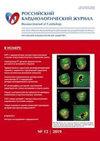机器学习在评估不同严重程度主动脉扩张患者升主动脉壁的大小和结构之间的关联时的应用
Q3 Medicine
引用次数: 0
摘要
目的评估非综合征非家族性(散发性)动脉瘤和主动脉瘤扩张的升主动脉(AA)壁病理变化与其平面特征之间的关联。研究纳入了 2010 年 1 月至 2015 年 7 月间接受择期手术的 174 名散发性动脉瘤和 AA 扩张患者,并将其分为两组:AA动脉瘤(AAA)(AA直径大于50毫米)和三尖瓣主动脉瓣(AV)伴有明显主动脉瓣狭窄(AS)或反流(AR)的患者(AAA组,n=120),以及AA边缘扩张(AA直径45-50毫米),伴有双尖瓣主动脉瓣(BAV)和明显AS的患者(BD组,n=54)。采用标准的临床旁检查和主动脉瓣壁病理检查。统计处理在 SPYDER 4.1.5 环境(Python 3.8)中进行,包括单变量相关分析、逻辑回归分析以及监督机器学习(ML)方法(支持向量机、k-近邻法、随机森林)。逻辑回归显示 AA 动脉粥样硬化与年龄、囊性内膜坏死(CMN)和瓦尔萨尔瓦窦(SV)直径呈正相关。支持向量机方法显示,CMN 患者 SV 层的 AA 有扩大的趋势(准确率为 60.5%),动脉粥样硬化患者的管状 AA 也有扩大的趋势(准确率为 79.2%)。在随机森林分析中,第一阶段是构建决策树来预测以下三种结果:是否存在 CMN、动脉粥样硬化或正常主动脉结构。模型准确率为 64.2%。接下来,将变量 "CMN "和 "动脉粥样硬化 "合并,预测结果为 "正常 AA 壁结构 "和 "病理 AA 壁结构"。模型准确率为 73.5%。使用 ML 为预测大动脉病变和以患者为中心的治疗方法提供了新的机会。在 AR 中,应采取更积极的 AA 干预措施。预测主动脉病变时,不应使用与体表面积相关的胸主动脉直径。对主动脉壁取样(环形切片),然后进行连续的病理检查可能会有希望。本文章由计算机程序翻译,如有差异,请以英文原文为准。
Machine learning in assessing the association between the size and structure of the ascending aortic wall in patients with aortic dilatation of varying severity
Aim. To assess the association between pathological ascending aortic (AA) wall changes and its planimetric characteristics in non-syndromic non-familial (sporadic) aneurysm and dilation of the AA.Material and methods. The study included 174 patients with sporadic aneurysms and dilation of the AA, who underwent elective surgery between January 2010 and July 2015 and were divided into 2 groups: patients with AA aneurysm (AAA) (AA diameter >50 mm) and tricuspid aortic valve (AV) with significant aortic stenosis (AS) or regurgitation (AR) (AAA group, n=120), and persons with borderline AA dilatation (AA diameter 45-50 mm), associated with a bicuspid aortic valve (BAV) and significant AS (BD group, n=54). Standard paraclinical investigations and pathological examination of the VA wall were used. Statistical processing was carried out in the SPYDER 4.1.5 environment (Python 3.8), and included univariate correlation analysis, logistic regression analysis, as well as supervised machine learning (ML) methods (support vector machine, k-nearest neighbor method, random forest).Results. Logistic regression revealed positive associations between AA atherosclerosis and age, cystic medial necrosis (CMN) and sinus of Valsalva (SV) diameters. The support vector machine method demonstrated a tendency towards AA expansion at the SV level in individuals with CMN (accuracy, 60,5%), as well as towards expansion of the tubular AA in atherosclerosis (accuracy, 79,2%). During the random forest analysis, the first stage was to construct decision trees to predict three following outcomes: the presence of CMN, atherosclerosis, or normal aortic structure. The model accuracy was 64,2%. Next, the variables "CMN" and "atherosclerosis" were combined, and prediction was made for the outcomes "normal AA wall structure" and "pathological AA wall structure". The model accuracy was 73,5%.Conclusion. The use of ML opens up new opportunities for predicting aortopathy and a patient-centered approach to treatment. In AR, a more aggressive AA intervention is warranted. To predict aortopathies, thoracic aorta diameters indexed to body surface area should not be used. Aortic wall sampling (circular section) followed by a continuous pathological examination may be promising.
求助全文
通过发布文献求助,成功后即可免费获取论文全文。
去求助
来源期刊

Russian Journal of Cardiology
Medicine-Cardiology and Cardiovascular Medicine
CiteScore
2.20
自引率
0.00%
发文量
185
审稿时长
1 months
期刊介绍:
Russian Journal of Cardiology has been issued since 1996. The language of this publication is Russian, with tables of contents and abstracts of all articles presented in English as well. Editor-in-Chief: Prof. Eugene V.Shlyakhto, President of the Russian Society of Cardiology.
The aim of the journal is both scientific and practical, also with referring to organizing matters of the Society. The best of all cardiologic research in Russia is submitted to the Journal. Moreover, it contains useful tips and clinical examples for practicing cardiologists. Journal is peer-reviewed, with multi-stage editing. The editorial board is presented by the leading cardiologists from different cities of Russia.
 求助内容:
求助内容: 应助结果提醒方式:
应助结果提醒方式:


